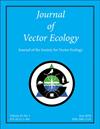在有替代猎物的情况下,淡水桡足类对伊蚊幼虫的猎物选择
IF 1.3
3区 农林科学
Q2 ENTOMOLOGY
引用次数: 0
摘要
摘要:捕食者-猎物相互作用会对物种的丰度和分布产生重大影响,但这些相互作用的结果往往依赖于环境。在小型淡水生境中,掠食性桡足类是蚊虫幼虫潜在的生物防治剂。通过室内实验,研究了非蚊类猎物(幼体水蚤)的存在是否会影响食肉桡足动物(棘环虫春足)对1龄伊蚊(埃及伊蚊和白纹伊蚊)的猎物选择。将桡足类动物分别以25只蚊子:75只水蚤、50只蚊子:50只水蚤、75只蚊子:25只水蚤为3种密度,饥饿12 h后暴露于两种猎物(幼虫蚊和水蚤)。每个物种的单一猎物选择试验以及无捕食者试验也建立了对照。桡足类是有效的捕食者,在24小时的试验中,一只桡足类可以吃掉37只1龄蚊子幼虫。叮蚊数量随蚊的相对密度增加而增加,但伊蚊占总蚊数的25%时叮蚊比例最高。研究结果表明,在一个简单的捕食者/双猎物系统中,两种幼虫蚊(伊蚊)埃及伊蚊和伊蚊。白纹伊蚊)会优先被桡足类捕食者棘环虫(Acanthocyclops vernalis)吃掉。本文章由计算机程序翻译,如有差异,请以英文原文为准。
Prey choice by a freshwater copepod on larval Aedes mosquitoes in the presence of alternative prey
ABSTRACT: Predator-prey interactions can have a significant impact on the abundance and distribution of species, but the outcome of these interactions is often context-dependent. In small freshwater habitats, predacious copepods are potential biological control agents for mosquito larvae. Through laboratory experiments, we tested if the presence of a non-mosquito prey (neonate Daphnia pulex) influenced prey selection of the predaceous copepod (Acanthocyclops vernalis) on 1st instar Aedes mosquitoes (Aedes aegypti and Aedes albopictus). Copepods were starved for 12 h prior to being exposed to the two prey types (larval mosquitoes and Daphnia) at three densities: 25 mosquitoes:75 Daphnia, 50 mosquitoes:50 Daphnia, 75 mosquitoes:25 Daphnia. Single prey choice trials for each species as well as no-predator trials were also established for controls. Copepods were effective predators, with a single copepod consuming up to 37 1st instar mosquito larvae during the 24-h trials. The number of mosquitoes consumed increased with their relative density, but the proportion of mosquitoes consumed was highest when Aedes made up only 25% of the population. Results from our study show that in a simple predator/two-prey system, two species of larval mosquitoes (Ae. aegypti and Ae. albopictus) are preferentially consumed over an alternative zooplankton by the copepod predator Acanthocyclops vernalis.
求助全文
通过发布文献求助,成功后即可免费获取论文全文。
去求助
来源期刊

Journal of Vector Ecology
生物-昆虫学
CiteScore
2.60
自引率
5.90%
发文量
31
审稿时长
6-12 weeks
期刊介绍:
The Journal of Vector Ecology is an international journal published by the Society for Vector Ecology. It is concerned with all aspects of the biology, ecology, and control of arthropod and vertebrate vectors and the interrelationships between the vectors and the agents of disease that they transmit. The journal publishes original research articles and scientific notes, as well as comprehensive reviews of vector biology based on presentations at Society meetings. All papers are reviewed by at least two qualified scientists who recommend their suitability for publication. Acceptance of manuscripts is based on their scientific merit and is the final decision of the editor, but these decisions may be appealed to the editorial board. The journal began publishing in 1974 and now publishes on-line only.
 求助内容:
求助内容: 应助结果提醒方式:
应助结果提醒方式:


